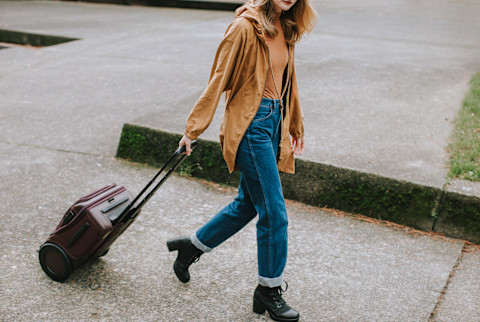
As parts of the world begin to open back up, we're remembering the joys—and the downsides—of international travel. Before you lump jet lag in as an inevitable pitfall of flying, you'll want to peep functional medicine doctor Frank Lipman, M.D.'s tricks for avoiding it altogether. After decades of navigating seven-hour time differences, the South African doc has become a pro at staying alert on the road using the following tried-and-true routine.
The travel itinerary that helps Frank Lipman, M.D., avoid jet lag.
What you'll find in his sleep kit.
These are the essentials Lipman keeps in his carry-on to ensure a seamless time transition:
- A sleep supplement
- An eye mask
- A water bottle
What he does on the plane.
On a recent episode of the mindbodygreen podcast, Lipman explained that his lag-fighting routine starts well before he reaches his destination. First, he'll take some melatonin when it's nighttime where he's headed.* (So let's say he's traveling to London, he'd take it at 4 p.m. in New York, 9 p.m. in London.)
"If you have a rhythm problem, melatonin and can be really helpful," Lipman says of why this sleep supplement is great for travel.* While it won't necessarily help enhance sleep quality (for that, he recommends magnesium), the hormone sends your body the signal that it's time for bed—even if it's the middle of the day.*
With that being said, he adds that "more is not better" and usually caps out his dose at 0.5 milligrams while traveling. He'll wash it down with plenty of water since staying hydrated is essential when you're flying.
What he does in the morning at his destination.
Lipman says that the first morning at his destination always includes the same two things: coffee and a walk outside.
"First thing in the morning, I'll have a cup of coffee and I'll go for a walk outside and get natural light," he explains. "I'm trying to get into a rhythm, and the coffee and the light will boost my cortisol and get me going." OK, we're following so far...
What he does at night at his destination.
Just as getting light in the morning can help your body acclimate, blocking light at night will help you sleep easier in a new time zone.
"Having a completely dark room is essential," Lipman explains, since "any little bit of light is going to inhibit your body's own production of melatonin." For this reason, he always travels with an eye mask.
Once it's time for lights out on that first night, he'll turn down the temperature of his room (67 degrees Fahrenheit is the warmest he recommends for sleep), take another melatonin to help his body acclimate, and begin the process of winding down from the day.*
"I always say you can't go at 100 miles an hour and then stop and expect to go to sleep," he explains. "There needs to be some transition period between your wake time and your sleep time." Your wind-down routine can involve a warm bath, restorative yoga, or, Lipman's personal favorite, calming music.
He aims for tunes that clock in at around 60 beats per minute, the rhythm of a slow heart rate, to send a signal to the body that the day is done and it's time to nod off for tomorrow's adventures.
The bottom line.
With a few simple tools and techniques, you can begin to acclimate to new environments faster. It's all about getting into a rhythm with a little help from the sun, the right supplements, and maybe a classical song or two.

